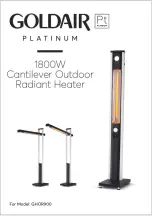
3. It is necessary during tuning to measure the current in the RHS cable using the
oscilloscope with a Rogowski coil. The cable current can not be above 300amps.
4. It is also useful to measure with an oscilloscope the voltage at the RHS capacitor rail. Using
a differential voltage probe monitor the Voltage across the RHS capacitor rail and compare
it to the unit display. The voltage on the RHS capacitor rail should be equal and in phase to
that of the unit.
As the power is increased the power supply should run at a frequency that is near
(within 10kHz) of the resonance frequency of the Remote Heat Station.
If the frequency is lower than the RHS resonance frequency, then the capacitance in the
Power Supply can be lowered, or the series inductor can be adjusted for lower
inductance.
If the frequency is higher than the load frequency, the capacitance in the power supply
can be increased, or the series inductance can be made larger.
If a frequency limit is reached, then series inductance should be made smaller. The
power supply capacitance may have to be increased to maintain a good match in
frequency.
If a current limit is reached, the series inductor should be adjusted for more inductance.
Capacitance may have to be removed from the power supply to maintain a good match
in frequency.
The cable current should be less than 300Apk . 100A would be optimal. If a current
measurement is not available. Monitor the temperature of the RHS cable to see that it
is not overheating during operation.
8


























